Family : Cercopithecidae

Text © Prof. Angelo Messina

English translation by Mario Beltramini
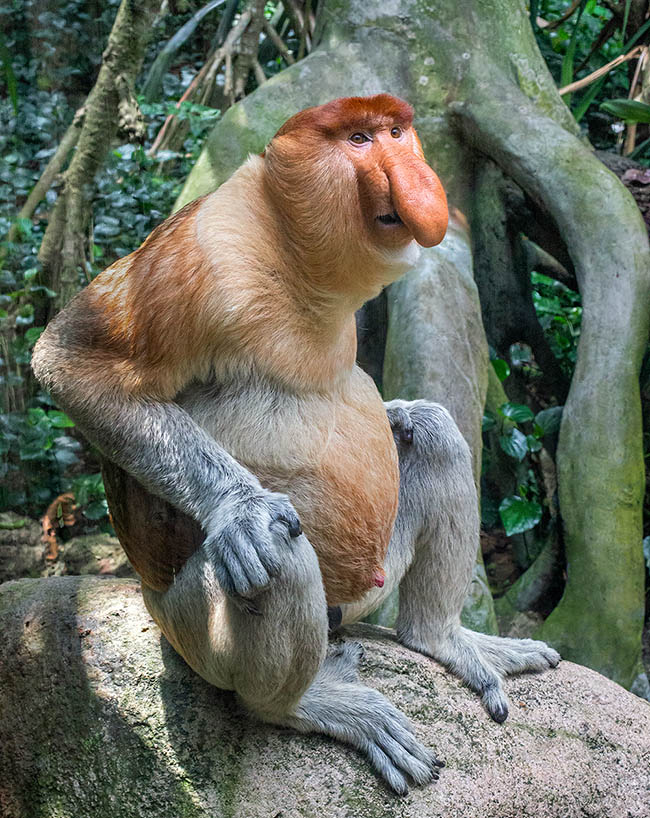
A male with big nose and belly is the top in the Proboscis monkey’s beauty canons © Giuseppe Mazza
Commonly known as Proboscis monkey or Long-nosed monkey, Nasalis larvatus (Wurmb, 1787) and called with a disparaging tone by the local populations “Monyet Belanda” (= Dutch monkey) due to its similarity in appearance with the Dutch colonizers, in particular for the long and red nose.
It is presently considered the only species of Nasalis, genus of Catarrhines monkeys of the family of the Cercopithecids.
In the past to the genus Nasalis have been attributed other species, such as Nasalis capistratus (Kerr, 1792), Nasalis nasica (Lacépède, 1799) and Nasalis recurvus (Vigors & Horsfield, 1828); nowadays these are considered by many specialists all synonyms of the only species of the genus, Nasalis larvatus, from the Latin “nasus larvatus” that means big nose.
Morphophysiology
One of the biggest monkeys in Asia, the Proboscis monkey has dimensions that in the males reach averagely 70 cm in length per a weight included between 16 and 22 kg. Females are smaller.
The tail is well developed, as long as the rest of the body, and has no tuft at the extremity.
Of a very singular aspect, the members of the genus Nasalis are so called because of the presence of a showy dangling and mobile nose, widened towards its half and run longitudinally by a deep groove.
This organ is particularly developed in the adult males where it gets the look of as small proboscis, 10 cm, and even more, long, capable of dilation and that gets to cover the mouth.
In females the nose is significantly smaller and turned upwards, even if bigger than that of other species of similar primates. The nostrils open below.
The particular shape of the nose, aided by the presence of a small laryngeal sac, works like a sound board, giving to the vocalizations of the males of Proboscis monkey a quite characteristic deep nasal intonation, similar to that of a bass.
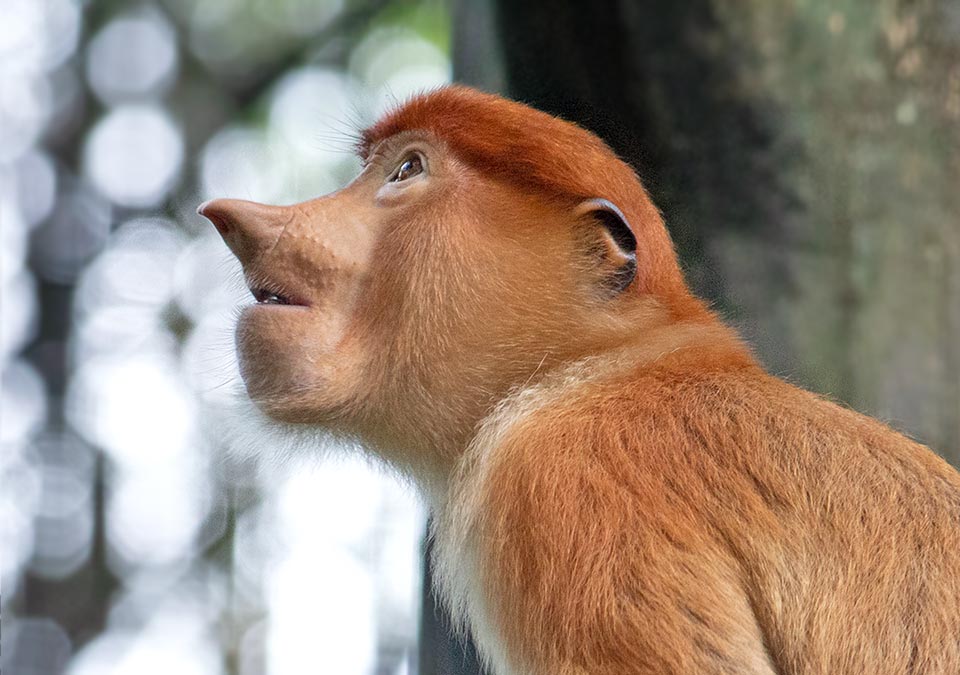
In fact, this female with upturned tiny French nose looks at him with admiration, hoping to be accepted in his group © Giuseppe Mazza
About the function of a such singular nose in the males, that in any case represents a secondary sexual character, there is no unity of views among the specialist; after some it has the function of a sexual call, after others it is a heat dispersion structure.
Being a characteristic exclusive of the male sex, and hence a clear element distinctive of the two sexes, we think it is clearly that the particular shape of the nose in the male individuals is primarily aimed at operating in the field of the reproductive relationships.
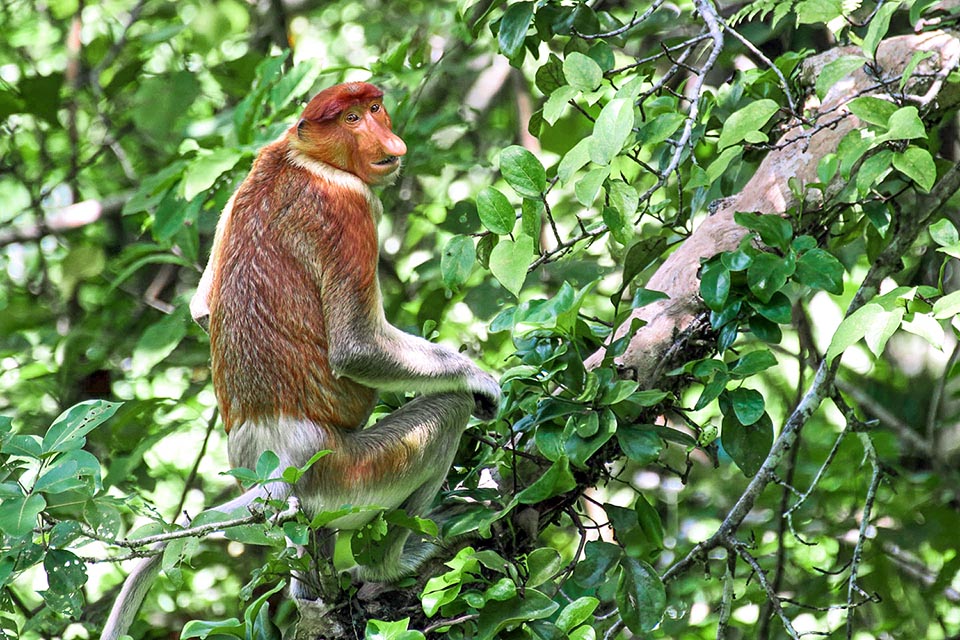
This, according to the modest nose and the sad look, probably belongs to the males ignored by the females that live in separate groups © Fernando Iglesias
Conversely, the hypothesis that the males are endowed with an instrument of heat dispersion that the females do not have looks for us at least not very sustainable.
The Proboscis monkey has a roundish head equipped with long hairs, with a very low front, eyes fairly wide apart and small ears. The face is adorned by a well-developed beard forming a yellowish collar around its neck.
The palms of the hands have no hairs, as well as the ischial callosities, well developed and usually of whitish colour.
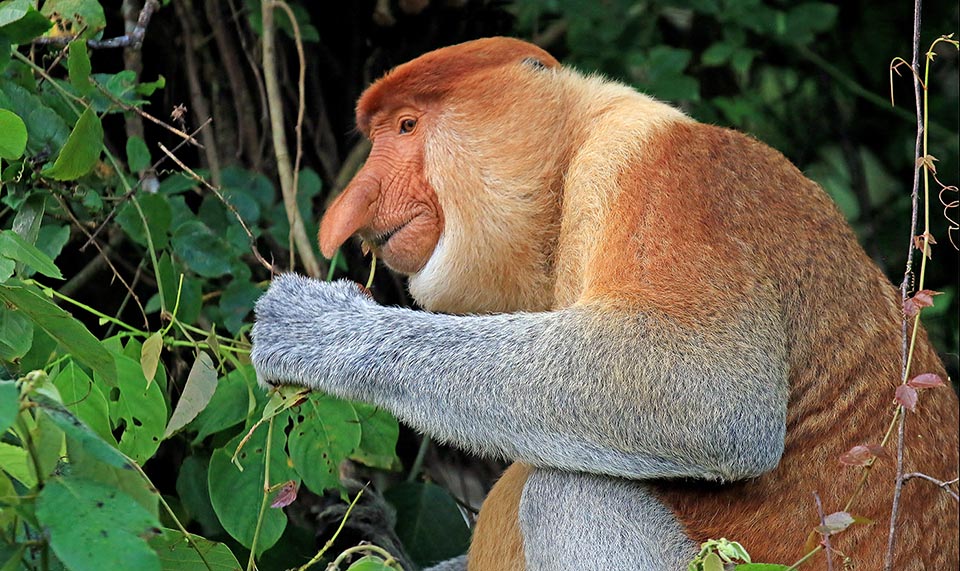
To have success is necessary to eat many leaves and some unripe fruit, occasionally integrated by invertebrates, like caterpillars and other insect larvae © John Tomsett
Besides the big nose of the males, another distinctive morphological element of the Proboscis monkey is the pronounced belly due to the significant accumulation of fat; this characteristic makes this monkey able to float very well and to be an excellent swimmer.
The body is covered by a thick and soft fur, more developed in the back part than in the lower one; on the head and on the shoulders the hairs have a red brown colouration, whilst on the chest and on the belly they get a pale yellow-reddish colour, with a white-greyish spot well delimited in the sacral region; the back and the sides are of pale yellow colour.
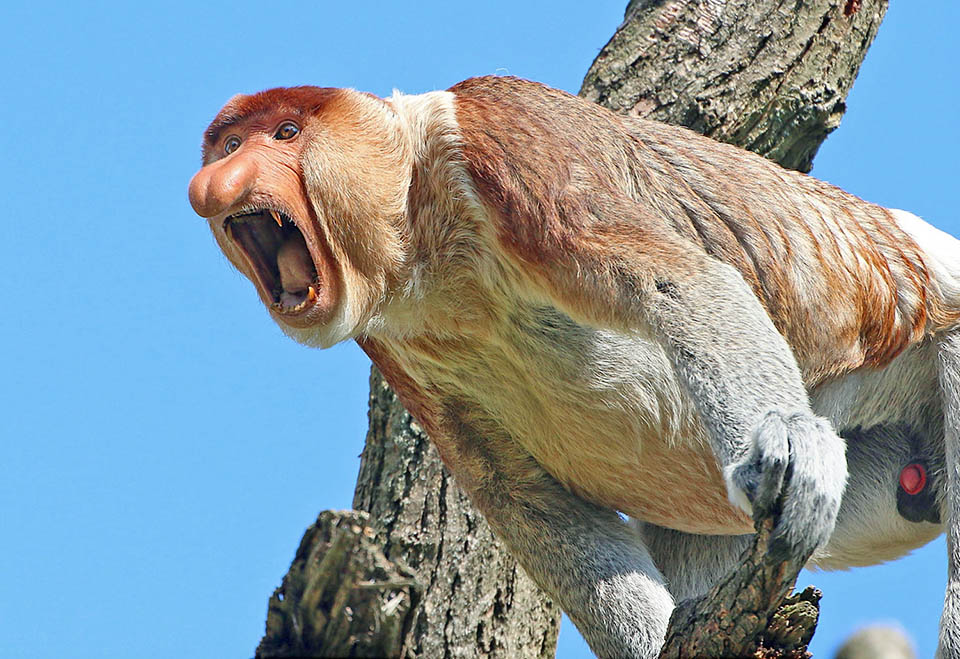
And then an influential male must be heard due to its strong vocalizations with the characteristic, bass-like, nasal tone, that reach great distances © Ger Bosma
The upper limbs are red yellowish, the lower ones grey-ash. The long tail is white with black extremity. The males have black scrotum and red penis.
Another characteristic that renders this monkey different from the other primates and clearly linked to its vegetable-based diet is the division of its stomach in more chambers like those of the ruminants; this, together with the bacteria flora of its digestive system, confers the Proboscis monkey the capacity of digesting the cellulose of which is rich its food.
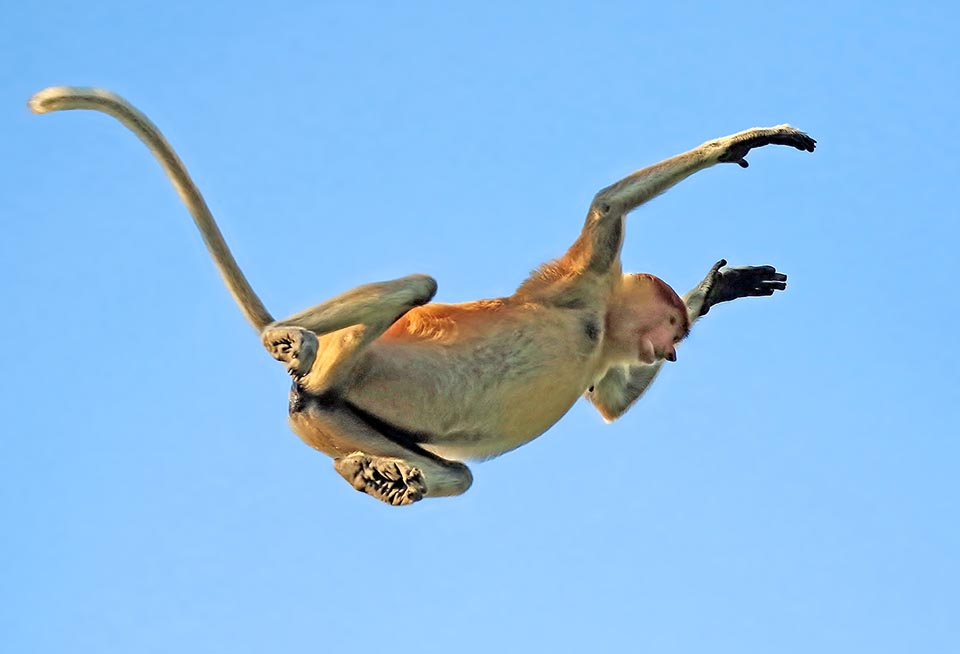
You must jump in the void, with 8 m leaps, to join the group or run away © John Tomsett
Zoogeography
Nasalis larvatus is a species endemic to Borneo, where it is confined in a very restricted habitat represented by the rainforests of the lowlands near inland waters, by the coastal mangroves and by the swamps.
Ecology-Habitat
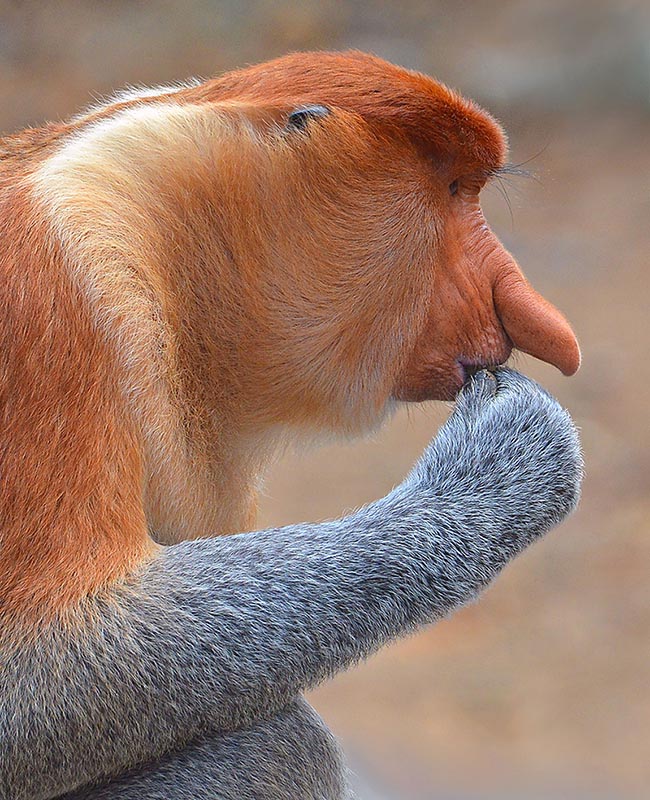
A boss must be able to evaluate pros and cons, and its sentences have no appeal © Roger Sargent Wildlife Photography
Essentially arboreal, it loves the highest tops of the gigantic trees that populate the virgin Borneo forest, in particular the forests of mangroves close to the water streams and on which at dusk it takes refuge to sleep.
Of diurnal habits, it is mainly active from late afternoon to evening.
The diet mainly consists of leaves and fruits, including those less ripe, even if occasionally the Proboscis monkey may eat invertebrates, such as caterpillars and larvae of insects.
Excellent climber and jumper, it is a particularly cautious monkey that, upon the least sign of danger, runs away to take shelter in the thick canopy of the trees, leaping quickly from branch to branch with jumps that may be long, even 8 m. It often dives into the water to escape.
Protected by the intricate and difficult environment of the mangroves, the Proboscis monkeys love the swampy environments and close to the water streams where they move with confidence swimming skillfully in the surface as well as in depth.
It has been observed that they are able to dive up to 20 m of depth and cover long distances swimming; despite the big belly also the males are able to swim underwater without difficulty.
The Proboscis monkeys count among their most dangerous predators the panther and the freshwater crocodile by whom they are usually attacked when they are immersing themselves into expanses of water or in water streams or stand close to their banks.
In order to minimize the danger of the predators, these monkeys often change the resting place, preferring the extremity of the branches that hang over the water.
Such a choice is motivated by the fact that, feeling the vibrations caused by the climbing of possible predators, the Proboscis monkeys have the time to dive directly into the water and run away carrying, stuck to the abdomen, their own pup.
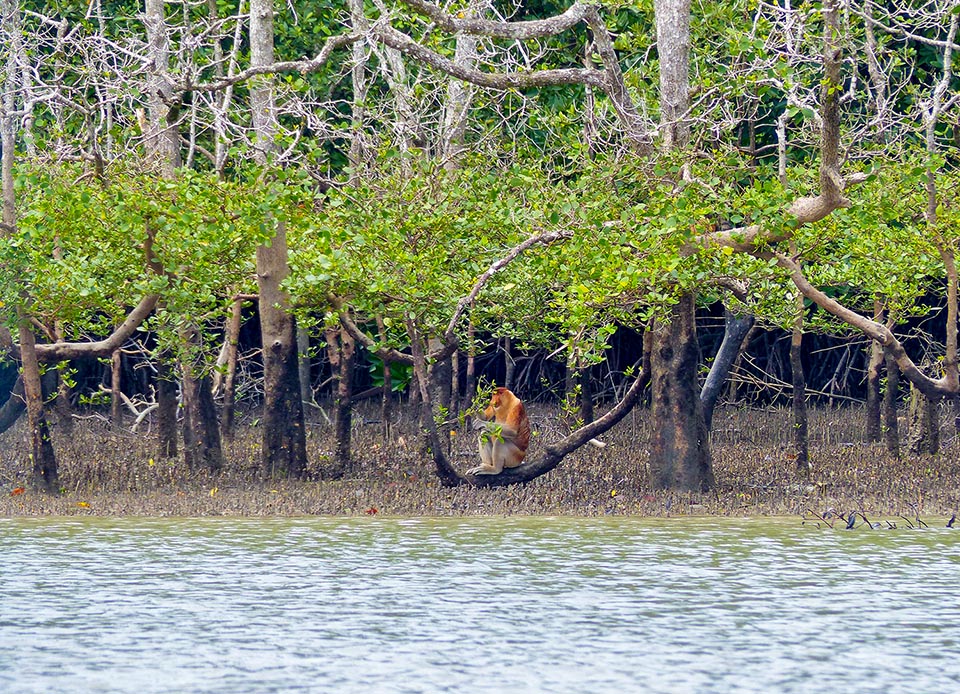
Proboscis monkey loves mangroves formations. They grant food and safety. As sleeping on branches drooping on water it can in fact dive swimming if a panther comes © Bernard Dupont
These and other behaviours to which add also facial expressions rather similar to the human ones denote the fact that the Proboscis monkeys have a good intelligence quotient.
They usually live in family groups formed by one single male with 2-7 adult females with their offspring.
Also, take form groups formed only by male individuals rejected by the females.
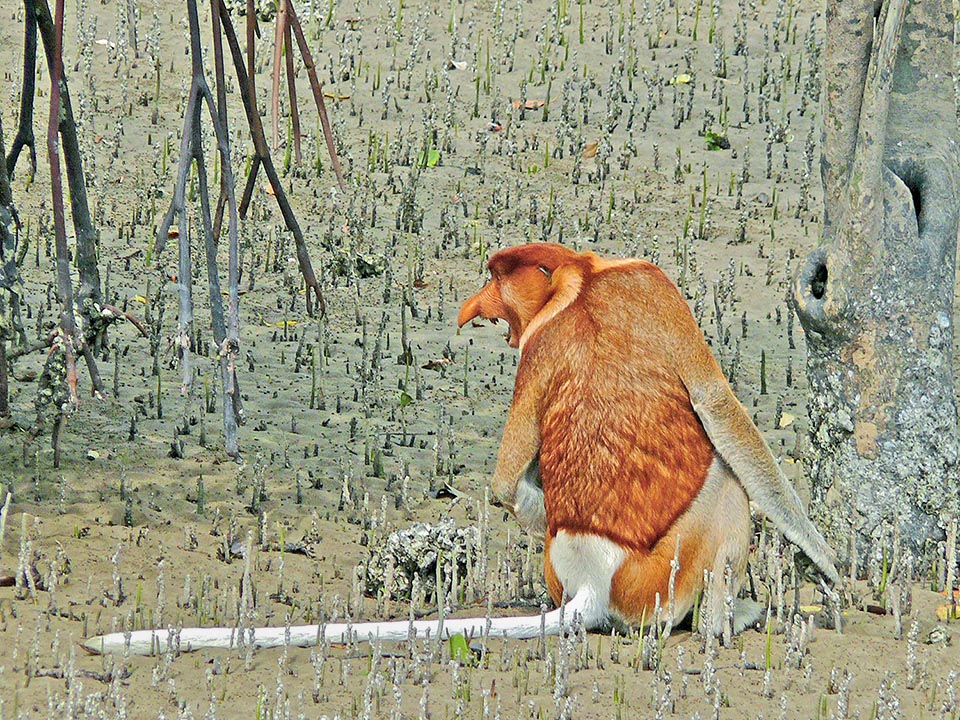
This defends its territory grinding the teeth and its showy Dutch-like nose, as the locals say, when they do not mock it for its white underpants © Bernard Dupont
Ethology-Reproductive Biology
The reproductive period of the Proboscis monkey goes from early spring to late autumn.
In this regard, some scholars have found significant correlations between the size of the nose of the males and the dimensions of the testicles and of the body in general, aspects conferring a physical attractiveness remarked by the females that increase their possibility to find a partner.
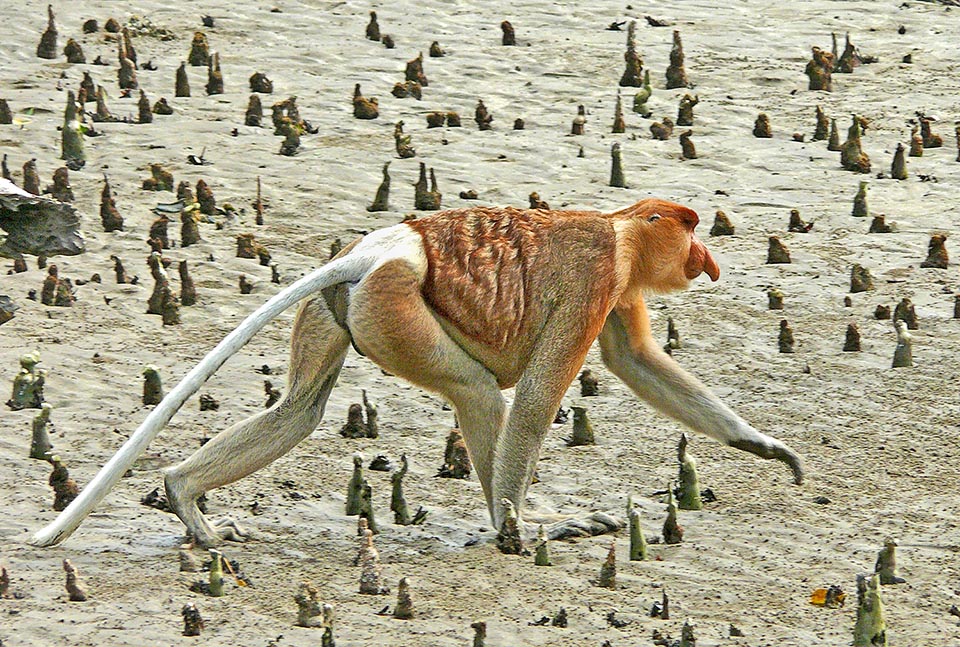
The less handsome withdraws and looks for another zone. Maybe it’s an ageing leader © Bernard Dupont
These observations suggest the existence of a relation between the dimensions of the nose and some sexual and reproductive capacities.
Besides the nose-proboscis, the Proboscis monkey males are also distinguished for other peculiarities, such as the powerful vocalizations and the manifestations related to the physical prowess and the competitiveness that allow them to conquer inside the group a high social position.
This may cause a certain monopolization of the females by some males and the formation of colonies formed uniquely by males that are less attractive to females.
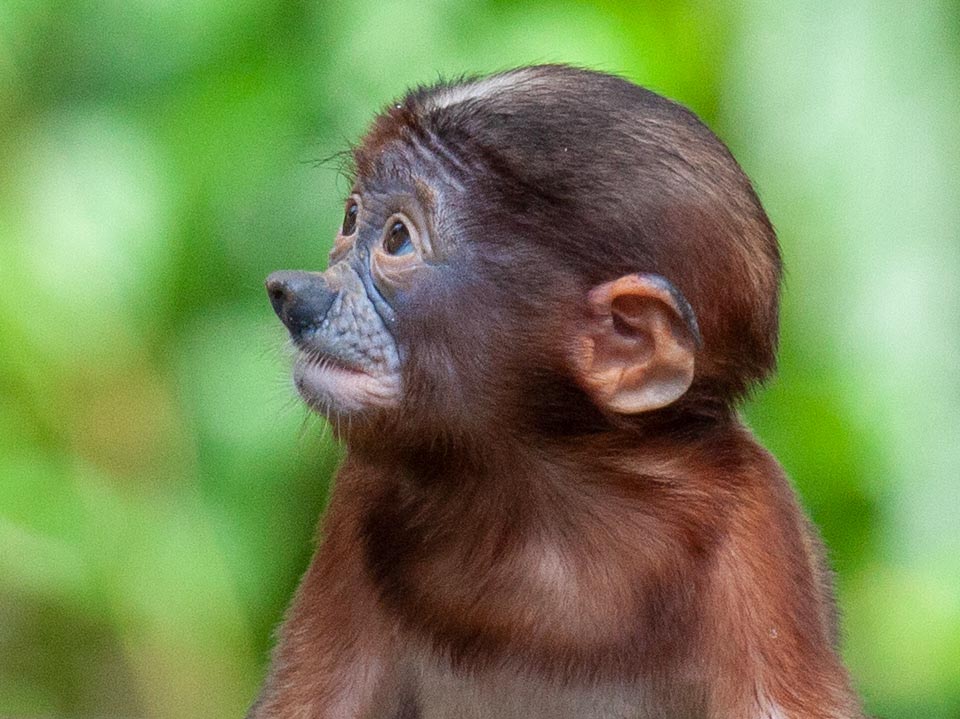
Conversely, pups are loved by the whole group. This is very young because doesn’t yet have a black face © Sergey Pisarevskiy
While courting, the males try to conquer the attentions of the females performing in tests of strength and agility with the help of characteristic vocalizations, amplified by the typical drooping nose: they jump on the foliage and on the dry branches, trying to give an image of power.
After a pregnancy of about 160 days, preferably during the night or morning hours, the females usually give birth to only one infant that has a small nose, the face of dark blue colour and black fur.
Immediately after the delivery, the females eat their own placenta. This practice (placentophagy) is diffused in a good part of the Mammals, man included, but little is precisely known about its biological significance.
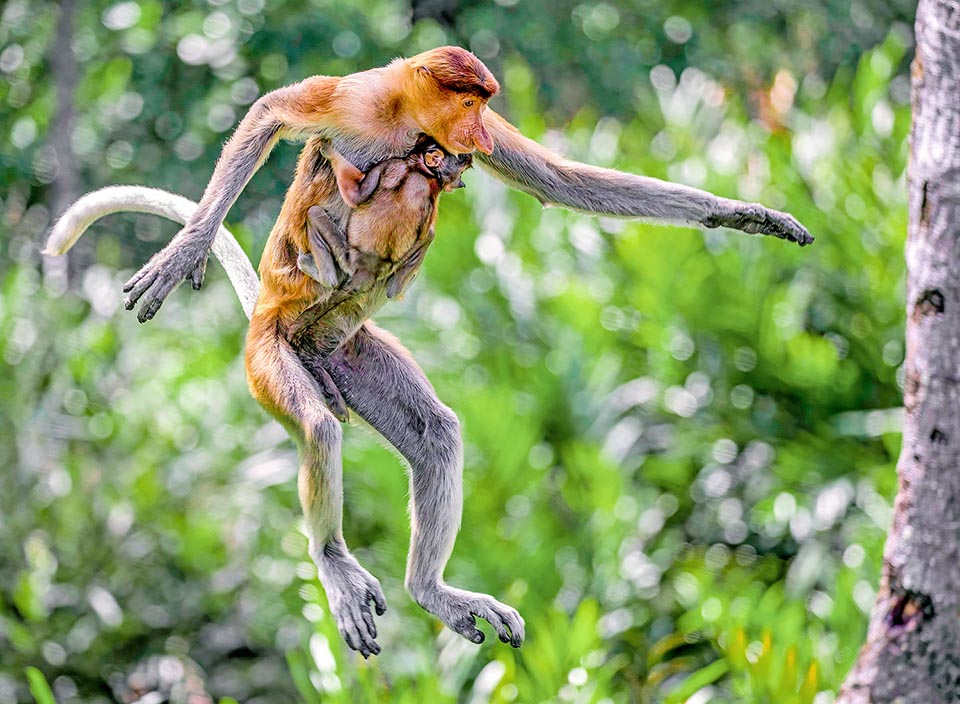
If mom is not there it can cling also to dad who carries it quickly far away from trouble © Peter Gosling
There is certainly the fact that the placenta is particularly rich in nutrients, as organ common between mother and unborn, intended for its protection and nutrition during its fetal life; it is also known that the placenta contains hormonal substances, such as oxytocin and prostaglandins that carry out a fundamental function during the delivery and the following care of the newborn.
This explains the many hypotheses existing on the reasons, probably all valid albeit to a different extent that lead the mother to eat its own placenta after the delivery: to eliminate a trace easy to locate by the predators of whom the newborn would be an easy prey, to give the pup, through the breastfeeding, the high energetic contents of this organ; and more, because the placenta contains substances that relieve the pain of childbirth, that induce mother and pup to establish a close relation between them.
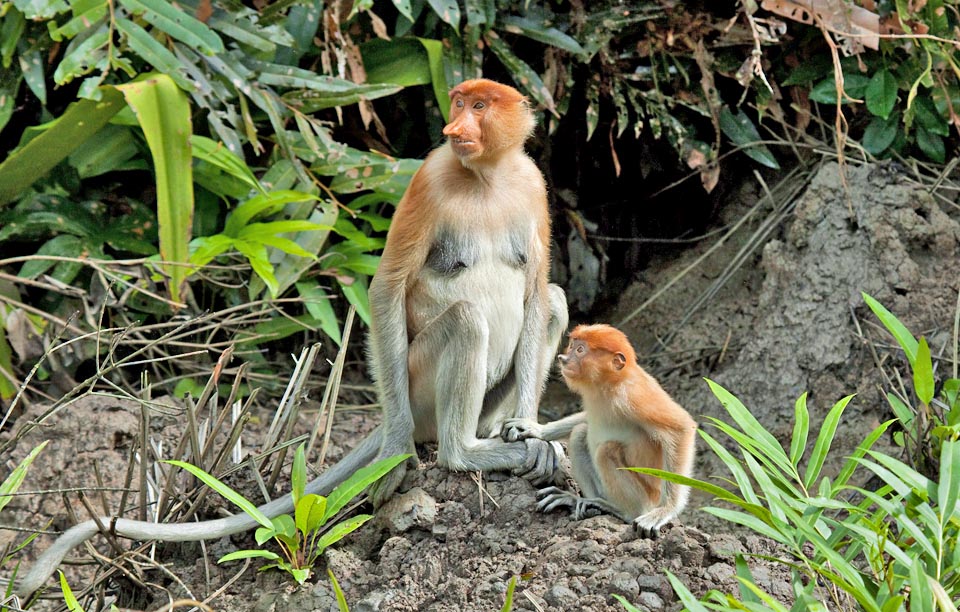
This close to mom is older, with the colouration already like that of adults © Sergey Pisarevskiy
With growth the nose of the infants develops in a different way in the males and in the females, whilst the face and the hair get the colours typical to the adults.
Upon birth, the pup is quite defenseless, and the mother carries it with her until when it is able to walk alone. It provides its breastfeeding up to the age of about 7 months and keeps it clean by grooming. Also the father concurs in the care of the pup and at times carries it stuck to its own abdomen.
The puppy is weaned when about 7 months old and may be cared for also by the other members of the group. The young stays with the mother till when she does not have another infant or till when it is not one year old.
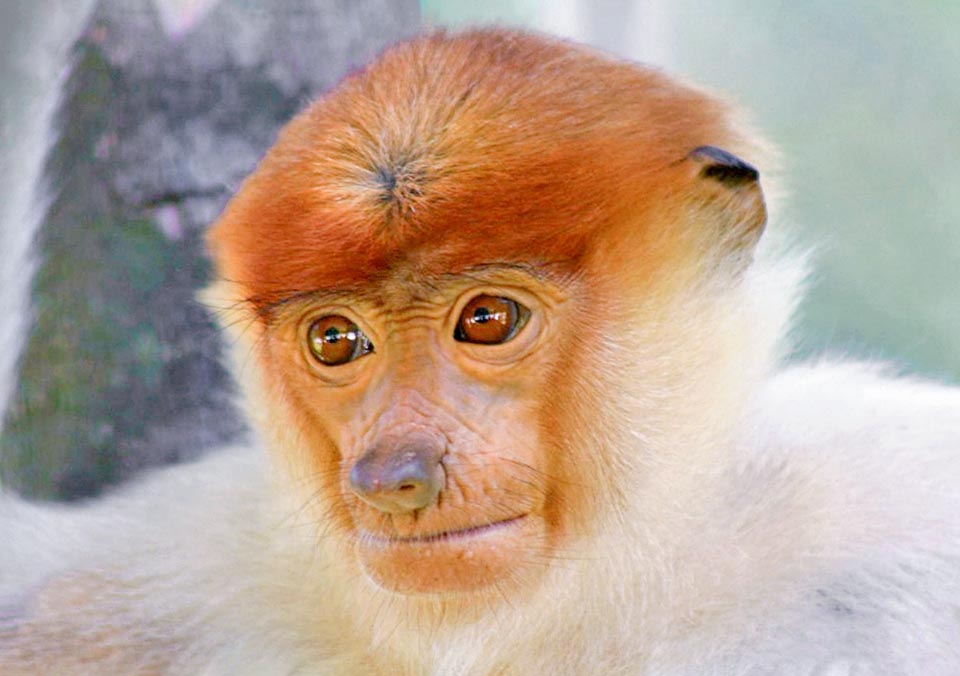
But here it is less carefree … perhaps at a certain age also the proboscis monkeys must go to school © ChieRong Chai
The sexual maturity of the young is reached between four and five years of age and the females become able to reproduce already when 5 years old. Once represented by numerically numerous populations, nowadays the species is strongly reduced.
Man has amply contributed in reducing the total population of these animals, presently formed by few thousands of individuals, and seriously jeopardize their survival subjecting them to a merciless hunt for eating their flesh, particularly appreciated and also for getting from the digestive system the so-called bezoar, a mass of concretions of undigested or not edible material, considered by oriental and medieval medicine as an effective antidote against any poison and a powerful amulet against evil.
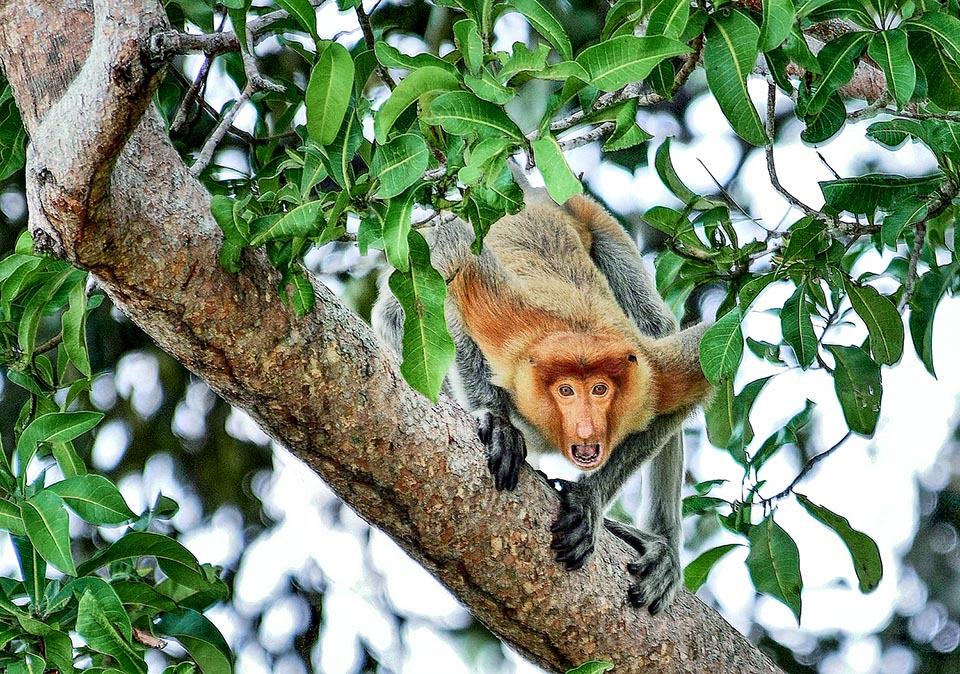
By studies end they learn to scream. This has maybe seen a man, its worst enemy, who with panthers and crocodiles is taking it to extinction © Joseph Kiesecker
Yore, the so-called bezoar stones were worn also by kings and queens as amulets or were ground and utilized as medicines; often they were put in a cup in the eventuality that inside this one there was some arsenic and with the hope that they could neutralize it.
More recently, the Proboscis monkey, especially due to the intensification of anthropic activities, in particular of the deforestation and of the practice of the mariculture of the shrimps, has seen its own habitat reducing drastically and presently is under serious risk of extinction.
Synonyms
Nasalis capistratus (Kerr, 1792); Nasalis nasica (Lacépède, 1799); Nasalis recurvus (Vigors & Horsfield, 1828).
